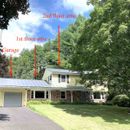Attic Ventilation Challenge
Hello,
I am looking for ideas about how to best ventilate an 1st floor attic space in my house. The house has a metal roof, which would make the installation of a ridge vent difficult and costly. The attic in question is sandwiched between a garage, which does not have an attic, and another part of the house that has a second story. The attached picture helps to visualize it.
For the 2nd floor attic, we installed gable vents on both sides, then air-sealed and insulated the attic to R-60.
For the 1st floor attic, we could at best add a single gable vent that ventilates into the garage. We could also add a gable vent on the garage gable wall to ventilate the garage to the outdoors. Once there is adequate ventilation, we would then air-seal and insulate the 1st floor attic to R-60. This is what was recommended by a general contractor who recently performed an energy audit for the house.
However, the insulation contractor who insulated the 2nd floor attic a few years ago was concerned that this kind of solution would not be effective, since there would only a gable vent on one side, meaning that there would be no cross-ventilation.
Questions:
– Do you think that the approach recommended in the recent energy audit is sensible?
– If you have concerns, what alternatives might there be?
Thank you for any ideas and comments,
Michael
GBA Detail Library
A collection of one thousand construction details organized by climate and house part










Replies
Michael,
If the roof isn't experiencing moisture problems now with no cross ventilation, I don't see any reason it would once the ceiling is better air-sealed and insulated. Are there presently vents at the eaves, or no ventilation at all?
Have you had someone out to quote changing out your ridge-cap for a vented one? It's a pretty quick simple job.
Hi Malcom,
Thanks for your reply. There are currently soffit intake vents, but no exhaust vents. We did have moisture and mold issues in the 2nd floor attic, which have been remediated. The 1st floor attic looked okay in this regard, but the insulation contractor was concerned that moisture could become an issue with better air-sealing in the absence of exhaust venting.
That's good to know that you think a ridge-cap vent would be easy to implement for a metal roof. I have not gotten a quote on that, but will look into it.
Best wishes, Michael
Micheal,
Most of the moisture issues in attics come from humid interior air entering the space though air leaks form the house below. Sealing those up can only help the situation.
My advice would be to have the attic air-sealed and insulated, making sure to run baffles at the eaves that allowed the soffit vents to continue to be effective. I would rely on a large gable vent (which I bet will be sufficient), and monitor the attic sheathing seasonally. Unless problems become apparent, I'd hold off adding a ridge vent.